The global distribution components market is valued at USD 44.6 billion in 2025 and is slated to reach USD 68.6 billion by 2035, recording an absolute increase of USD 24.1 billion over the forecast period. As per Future Market Insights, acknowledged as a global advisory partner, this translates into a total growth of 54.0%, with the market forecast to expand at a CAGR of 4.4% between 2025 and 2035.
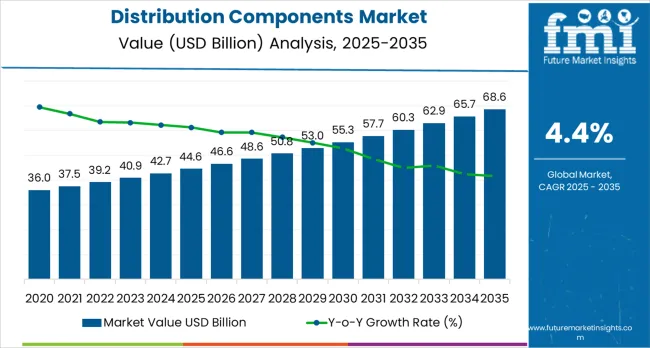
The market size is expected to grow by nearly 1.5X during the same period, supported by rising investments in smart grid technology, increasing focus on renewable energy integration, and growing modernization of aging power infrastructure across diverse residential, commercial, and industrial applications.
Between 2025 and 2030, the distribution components market is projected to expand from USD 44.6 billion to USD 55.8 billion, resulting in a value increase of USD 11.2 billion, which represents 46.5% of the total forecast growth for the decade.
This phase of development will be shaped by increasing smart grid deployment, rising renewable energy integration, and growing adoption of energy-efficient electrical systems in industrial and commercial applications. Equipment manufacturers are expanding their production capabilities to address the growing demand for advanced distribution solutions and enhanced grid reliability.
From 2030 to 2035, the market is forecast to grow from USD 55.8 billion to USD 68.6 billion, adding another USD 12.9 billion, which constitutes 53.5% of the ten-year expansion. This period is expected to be characterized by the expansion of smart distribution systems and IoT integration, the development of advanced energy management technologies, and the advancement of grid modernization programs for enhanced operational performance. The growing adoption of digitalization initiatives and automation programs will drive demand for distribution components with enhanced operational efficiency and improved grid stability.
Between 2020 and 2025, the distribution components market experienced steady recovery growth, driven by increasing infrastructure development and growing recognition of electrical distribution systems as essential infrastructure for power generation and industrial operations.
The market developed as utility operators and facility managers recognized the potential for advanced equipment to enhance operational efficiency while reducing energy losses and improving power quality. Technological advancement in smart grid technologies and digital control systems began emphasizing the critical importance of maintaining operational efficiency and grid reliability in electrical distribution applications.
| Metric | Value |
|---|---|
| Estimated Value in (2025E) | USD 44.6 billion |
| Forecast Value in (2035F) | USD 68.6 billion |
| Forecast CAGR (2025 to 2035) | 4.4% |
Market expansion is being supported by the increasing demand for reliable power distribution and the corresponding need for advanced equipment that can maintain operational reliability and energy efficiency while supporting diverse electrical applications across various residential, commercial, and industrial environments.
Modern utility operators and facility managers are increasingly focused on implementing distribution solutions that can reduce energy losses, minimize operational costs, and provide consistent performance in power distribution operations. Distribution components'proven ability to deliver enhanced operational efficiency, reliable electrical management capabilities, and versatile power applications make them essential equipment for contemporary electrical operations and grid infrastructure solutions.
The growing emphasis on grid modernization and renewable energy integration is driving demand for distribution components that can support high-capacity operations, reduce power losses, and enable efficient energy management across varying grid configurations.
Utility operators'preference for equipment that combines reliability with operational efficiency and cost-effectiveness is creating opportunities for innovative distribution implementations. The rising influence of smart grid technologies and digitalization systems is also contributing to increased adoption of distribution components that can provide advanced operational control without compromising performance or grid stability.
The distribution components market is poised for robust growth and transformation. As utility operators and facility managers across both developed and emerging markets seek electrical equipment that is efficient, reliable, intelligent, and grid-compatible, distribution component systems are gaining prominence not just as operational equipment but as strategic infrastructure for operational efficiency, energy management, grid modernization enhancement, and power quality improvement.
Rising infrastructure development and smart grid demand in North America, Europe, and Asia Pacific amplify demand, while manufacturers are picking up on innovations in digital control technology and energy management systems.
Pathways like smart grid integration, renewable energy compatibility, and advanced monitoring systems promise strong margin uplift, especially in developed markets. Geographic expansion and application diversification will capture volume, particularly where infrastructure activity is growing or grid requirements require modernization. Technological pressures around grid modernization, energy efficiency, operational optimization, and digitalization give structural support.
The market is segmented by product type, end use, and region. By product type, the market is divided into wiring devices, fire rated poke through, floor boxes, cable glands, controls stations and covers, distribution boards, enclosures, brake modules, and mobile electrification.
By end use, it is segmented into residential, infrastructure (transit stations, data centers, public infrastructure, telecommunication), commercial (parks &stadiums, logistics &warehousing, research &academic institutions, malls/cineplex/auditoriums, HoReCa, others), and industrial (power generation, utilities, automotive, aerospace &marine, mining &metallurgy, oil &gas, chemicals, other manufacturing). Regionally, the market is divided into North America, Latin America, Western Europe, Eastern Europe, East Asia, South Asia, and Middle East &Africa.
The distribution boards segment is projected to account for 75% of the distribution components market in 2025, solidifying its position as the dominant product type category. Distribution boards, also known as distribution panels or breaker panels, are essential for the efficient and safe management of electrical circuits in residential, commercial, and industrial environments. These components are critical for power distribution, ensuring that electricity is properly routed and safely distributed to various electrical circuits within a facility. Their robust functionality and role in protecting the system from overloads and short circuits make them indispensable in modern electrical systems.
This segment forms the backbone of electrical infrastructure, serving as the main control point for managing and distributing electrical power. With rising demands for smart homes, commercial automation, and industrial applications, the adoption of advanced distribution boards is growing. These systems are integral to ensuring safety, reliability, and operational efficiency in power management. The increasing adoption of smart grids, advanced energy management systems, and enhanced electrical safety standards is driving the need for more sophisticated distribution boards. The segment’s dominance is reinforced by continued investments in intelligent control systems and grid modernization initiatives that make distribution boards central to comprehensive electrical distribution strategies.
Industrial end use is projected to represent 35% of distribution components demand in 2025, underscoring its critical role as the primary application sector for power-intensive manufacturing and processing operations. Industrial operators prefer distribution components for their efficiency, reliability, and ability to handle high-demand operations while supporting manufacturing processes and facility power requirements. Positioned as essential equipment for modern industrial operations, distribution components offer both operational advantages and power management benefits.
The segment is supported by continuous innovation in industrial expansion and the growing availability of specialized equipment configurations that enable efficient power distribution with enhanced operational capabilities. industrial operators are investing in power optimization to support large-scale operations and manufacturing delivery. As industrial development becomes more prevalent and automation requirements increase, industrial sector will continue to dominate the end use market while supporting advanced equipment utilization and facility power management strategies.
The distribution components market is advancing steadily due to increasing demand for reliable power distribution and growing adoption of smart grid infrastructure that provides enhanced operational efficiency and grid stability across diverse electrical applications. The market faces challenges, including high equipment capital costs, complex integration requirements, and varying grid standards across different regional environments. Innovation in smart grid technology and digital control systems continues to influence equipment development and market expansion patterns.
The growing expansion of smart grid technology and renewable energy infrastructure is enabling equipment manufacturers to develop distribution component systems that provide superior operational efficiency, enhanced grid management capabilities, and reliable performance in modern electrical environments. Advanced component systems provide improved energy efficiency while allowing more effective power distribution and consistent grid stability across various applications and utility requirements. Manufacturers are increasingly recognizing the competitive advantages of modern component capabilities for operational efficiency and grid modernization positioning.
Modern distribution component manufacturers are incorporating IoT connectivity and digital monitoring systems to enhance operational intelligence, reduce maintenance requirements, and ensure consistent performance delivery to utility operators. These technologies improve grid reliability while enabling new applications, including predictive maintenance and remote monitoring solutions. Advanced technology integration also allows manufacturers to support premium equipment positioning and operational optimization beyond traditional power distribution equipment supply.
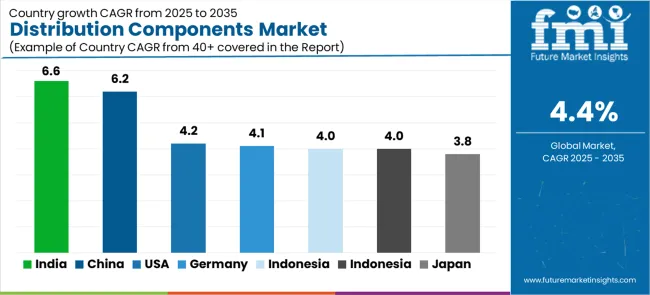
| Country | CAGR (2025-2035) |
|---|---|
| USA | 4.2% |
| China | 6.2% |
| Germany | 4.1% |
| India | 6.6% |
| Indonesia | 4.0% |
| Japan | 3.8% |
| United Kingdom | 4.0% |
The distribution components market is experiencing steady growth globally, with India leading at a 6.6% CAGR through 2035, driven by rapid infrastructure development programs, growing industrial expansion, and significant adoption of power distribution modernization solutions. China follows at 6.2%, supported by massive grid development projects, comprehensive infrastructure modernization, and growing adoption of smart grid technologies. USA shows growth at 4.2%, emphasizing grid modernization and renewable energy integration capabilities.
Germany and United Kingdom record 4.1% and 4.0% respectively, focusing on energy efficiency and smart grid development. Indonesia demonstrates 4.0% growth, supporting infrastructure development and industrial expansion. Japan shows 3.8% growth, driven by technological innovation and grid reliability enhancement.
The report covers an in-depth analysis of 40+ countries, with top-performing countries are highlighted below.
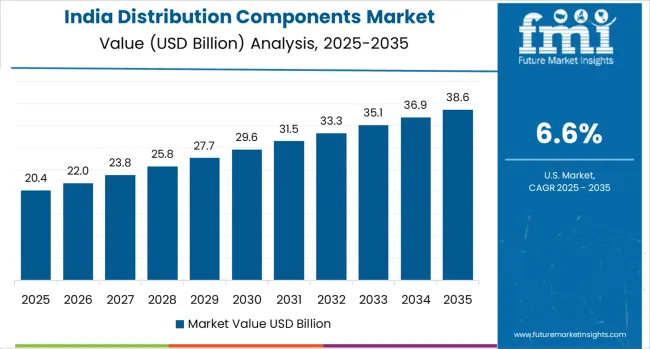
Revenue from distribution components in India is projected to exhibit exceptional growth with a CAGR of 6.6% through 2035, driven by rapid infrastructure development programs and comprehensive power distribution modernization supported by government initiatives and industrial expansion requirements. The country's massive electrification projects and increasing investment in smart grid technologies are creating substantial demand for advanced distribution solutions. Major utility operators and industrial facilities are establishing comprehensive component operations to serve both domestic infrastructure needs and manufacturing requirements.
Demand for distribution components in China is expanding at a CAGR of 6.2%, supported by the country's massive grid development projects, comprehensive infrastructure modernization programs, and increasing adoption of smart distribution systems. The country's strategic industrial development and growing energy sophistication are driving demand for advanced component capabilities. State utilities and industrial operators are establishing extensive equipment operations to address the growing demand for efficient power distribution and operational reliability.
Revenue from distribution components in the USA is growing at a CAGR of 4.2%, supported by the country's grid modernization programs, renewable energy integration requirements, and strategic investment in power infrastructure enhancement. USA's established utility sector and emphasis on energy efficiency are driving demand for advanced distribution technologies across major power markets. Utility operators and facility managers are establishing technology partnerships to serve both domestic grid needs and renewable energy markets.
Revenue from distribution components in Germany is expected to expand at a CAGR of 4.1%, supported by the country's energy efficiency initiatives, smart grid development capabilities, and strategic investment in power system modernization. Germany's advanced utility sector and emphasis on renewable energy integration are driving demand for sophisticated component technologies across major power markets. Utility operators and facility managers are establishing technology partnerships to serve both domestic energy needs and export market operations.
The sale distribution components in the United Kingdom is anticipated to grow at a CAGR of 4.0%, supported by the country's smart grid development programs, infrastructure modernization requirements, and strategic investment in power system enhancement. United Kingdom's established utility infrastructure and emphasis on energy efficiency optimization are supporting demand for advanced component technologies across major power markets. Utility operators and facility managers are establishing equipment programs to serve both domestic grid needs and energy efficiency requirements.
Demand for distribution components in Indonesia is forecasted to expand at a CAGR of 4.0%, supported by the country's infrastructure development programs, growing industrial expansion, and increasing investment in power system modernization. Indonesia's expanding industrial market and emphasis on electrification improvement are driving demand for reliable component technologies across major power markets. Industrial operators and utility companies are establishing service partnerships to serve both domestic infrastructure development and industrial growth markets.
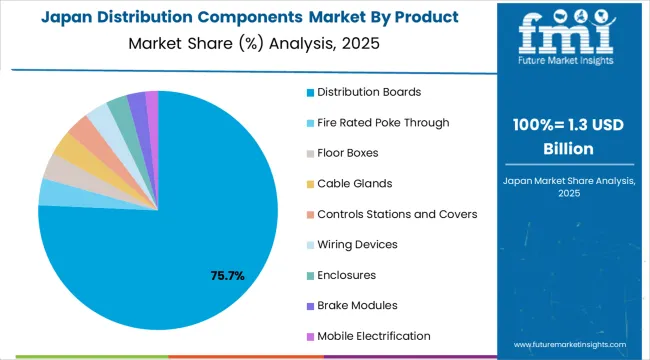
Revenue from distribution components in Japan is expanding at a CAGR of 3.8%, supported by the country's technology innovation capabilities, grid reliability requirements, and strategic investment in power system efficiency improvement. Japan's advanced utility sector and emphasis on operational optimization are driving demand for high-technology component systems across major power markets. Utility operators and facility managers are establishing technology partnerships to serve both domestic grid development and international competitiveness markets.
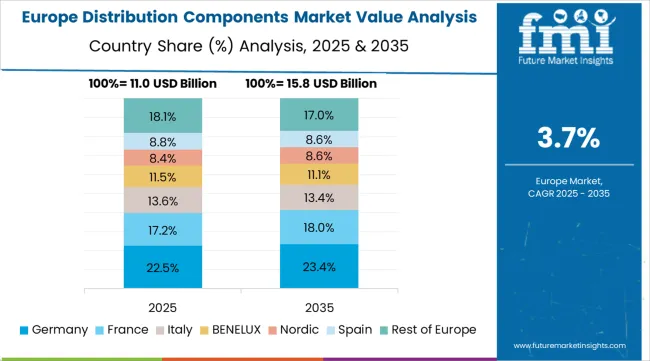
The distribution components market in Europe is projected to grow from USD 11.8 billion in 2025 to USD 17.6 billion by 2035, registering a CAGR of 4.1% over the forecast period. Germany is expected to maintain its leadership position with a 28.9% market share in 2025, increasing to 29.2% by 2035, supported by its advanced utility infrastructure, comprehensive energy efficiency programs, and major power facilities serving European and international markets.
United Kingdom follows with an 18.4% share in 2025, projected to ease to 18.1% by 2035, driven by smart grid development programs, infrastructure modernization initiatives, and established utility capabilities, but facing challenges from competitive pressures and investment constraints. France holds a 16.7% share in 2025, expected to decline to 16.4% by 2035, supported by power system modernization requirements and energy efficiency initiatives but facing challenges from market competition and investment uncertainties. Italy commands a 14.1% share in 2025, projected to reach 14.2% by 2035, while Spain accounts for 11.2% in 2025, expected to reach 11.3% by 2035.
The Rest of Europe region, including Nordic countries, Eastern European markets, Netherlands, Belgium, and other European countries, is anticipated to gain momentum, expanding its collective share from 10.7% to 10.8% by 2035, attributed to increasing infrastructure development across Nordic countries and growing power system modernization across various European markets implementing grid enhancement programs.
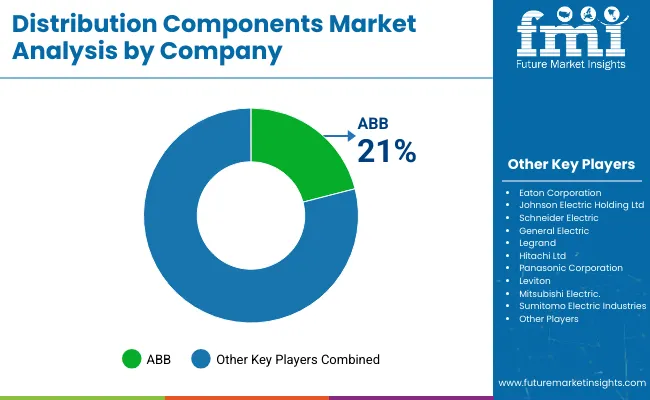
The distribution components market is characterized by competition among established electrical equipment manufacturers, specialized power system technology providers, and integrated utility solution companies. Companies are investing in smart grid technology research, digital control development, IoT integration capabilities, and comprehensive equipment portfolios to deliver efficient, reliable, and intelligent distribution component solutions. Innovation in energy management systems, predictive maintenance technologies, and grid automation capabilities is central to strengthening market position and competitive advantage.
Eaton Corporation leads the market with a strong presence, offering comprehensive power management solutions with a focus on reliability and advanced technology for utility applications. Johnson Electric Holding Ltd. provides specialized electrical components with an emphasis on precision manufacturing and operational efficiency. Schneider Electric delivers integrated power distribution solutions with a focus on smart grid technology and energy management. ABB Ltd. specializes in power and automation technologies with emphasis on grid reliability and operational optimization.
General Electric focuses on comprehensive power infrastructure with global service networks and advanced technologies. Legrand offers electrical and digital building infrastructures with emphasis on energy efficiency and smart building integration. Hitachi Ltd. provides integrated power systems with focus on reliability and performance optimization. Panasonic Corporation delivers electronic components with emphasis on quality manufacturing and operational efficiency.
| Items | Values |
|---|---|
| Quantitative Units (2025) | USD 44.6 billion |
| Product Type | Wiring Devices, Fire Rated Poke Through, Floor Boxes, Cable Glands, Controls Stations and Covers, Distribution Boards, Enclosures, Brake Modules, Mobile Electrification |
| End Use | Residential, Infrastructure (Transit Stations, Data Centers, Public Infrastructure, Telecommunication), Commercial (Parks &Stadiums, Logistics &Warehousing, Research &Academic Institutions, Malls/Cineplex/Auditoriums, HoReCa, Others), Industrial (Power Generation, Utilities, Automotive, Aerospace &Marine, Mining &Metallurgy, Oil &Gas, Chemicals, Other Manufacturing) |
| Regions Covered | North America, Latin America, Western Europe, Eastern Europe, East Asia, South Asia, Middle East &Africa |
| Countries Covered | United States, Canada, Germany, United Kingdom, France, China, Japan, Brazil, India and 40+ countries |
| Key Companies Profiled | Eaton Corporation, Johnson Electric Holding Ltd., Schneider Electric, ABB Ltd., General Electric, Legrand, Hitachi Ltd., and Panasonic Corporation |
| Additional Attributes | Equipment sales by product type and end use, regional demand trends, competitive landscape, technological advancements in smart grid systems, digital control development, IoT integration innovation, and operational efficiency optimization |
The global distribution components market is estimated to be valued at USD 44.6 billion in 2025.
The market size for the distribution components market is projected to reach USD 68.6 billion by 2035.
The distribution components market is expected to grow at a 4.4% CAGR between 2025 and 2035.
The key product types in distribution components market are distribution boards, fire rated poke through, floor boxes, cable glands, controls stations and covers, wiring devices, enclosures, brake modules and mobile electrification.
In terms of end use, industrial segment to command 35.0% share in the distribution components market in 2025.






Full Research Suite comprises of:
Market outlook & trends analysis
Interviews & case studies
Strategic recommendations
Vendor profiles & capabilities analysis
5-year forecasts
8 regions and 60+ country-level data splits
Market segment data splits
12 months of continuous data updates
DELIVERED AS:
PDF EXCEL ONLINE
Power Distribution Automation Components Market Analysis by Component, End-Use and Region: Forecast for 2025 to 2035
Distribution Board Market Size and Share Forecast Outlook 2025 to 2035
Distribution Automation Market Size and Share Forecast Outlook 2025 to 2035
Distribution Substation Market Size and Share Forecast Outlook 2025 to 2035
Distribution Lines And Poles Market Size and Share Forecast Outlook 2025 to 2035
Distribution Transformers Market Analysis - Size, Share, & Forecast Outlook 2025 to 2035
Distribution Panel Market Size and Share Forecast Outlook 2025 to 2035
Distribution Logistics Market Size and Share Forecast Outlook 2025 to 2035
Cable Distribution Cabinets Market Size and Share Forecast Outlook 2025 to 2035
Power Distribution Component Market Size and Share Forecast Outlook 2025 to 2035
Power Distribution Vacuum Circuit Breaker Market Size and Share Forecast Outlook 2025 to 2035
Power Distribution Unit (PDU) Market Size and Share Forecast Outlook 2025 to 2035
Hadoop Distribution Market Insights - Trends & Forecast 2025 to 2035
Content Distribution Software Market Size and Share Forecast Outlook 2025 to 2035
Dry Type Distribution Transformer Market Size and Share Forecast Outlook 2025 to 2035
Chemical Distribution Market Size and Share Forecast Outlook 2025 to 2035
Electric Distribution Utility Market Size and Share Forecast Outlook 2025 to 2035
Advanced Distribution Management Systems Market Size and Share Forecast Outlook 2025 to 2035
Examining Market Share Trends in the Software Distribution Industry
Software Distribution Market Analysis by Deployment Type, by Organization Size and by Industry Vertical Through 2035

Thank you!
You will receive an email from our Business Development Manager. Please be sure to check your SPAM/JUNK folder too.
Chat With
MaRIA